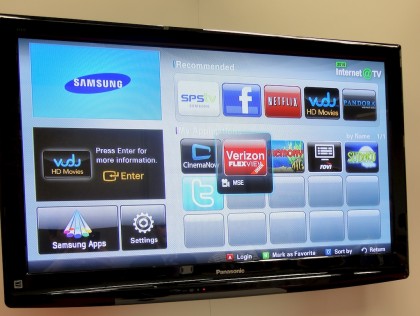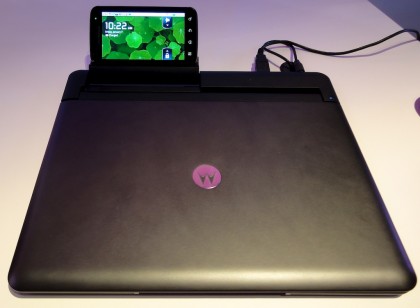Amongst all the dazzling new televisions and parade of tablet devices, there were two products and services that clearly stood out during my abbreviated CES journey.
FiOS TV… As An App
While we saw at least three methods of bypassing the cable box at CES, none excited me more than the Verizon FiOS TV approach. Verizon’s collaborated with both Samsung and Panasonic to load up their IMG 1.9 TV/DVR experience as an app on various connected devices. Such as the Samsung BD-C6900 as photographed above. Additionally, Verizon has ported their new IP-based television experience to some game consoles they’re not quite ready to disclose. All told, they’ve currently got FiOS TV running on over 3 dozen devices… that are not cable boxes. What if your PS3 was also your DVR? Or your Blu-ray player was your extender? And your live “cable” TV was built into your connected television? I’m confident Verizon will succeed where the lethargic cable industry’s tru2way initiative has failed. And this is only 2/3rd of the news that excites me. The other third has me even more giddy (as a new FiOS TV customer) and is something we’ll hopefully be able to cover in the near future.
Motorola Atrix Smartphone/Netbook Combo
Dozens and dozens on Android-powered devices were on display at CES. But none were more powerful, attractive, or clever than the Motorola Atrix. By itself, the Atrix is a top flight smartphone boasting superior specs. But Moto has sweetened the deal by mating it with an optional companion laptop module. Pop the Atrix into the accessory and the 11″ netbook, with 6-8hr battery life, springs to life via a custom “webtop” app that resides on the phone. You’re not just tethering your data services, you’re tethering the processor, storage, and operating system as well. Unfortunately the critical question of “How much?” remains unanswered.


Atrix is an interesting concept. If it actually becomes a popular item, Samsung should jump on this idea — they are bound to create a much better laptop/netbook that Moto.
FiOS is interesting and all, but it’s just solving the problem of having extra set-top boxes in secondary locations. Meaning, Verizon won’t be offering programming to people with, say, Comcast internet service, right?
They didn’t mention it… but I spoke of similar with Microsoft regarding AT&T U-verse services at CES 2010 and 2011.
So basically, they are trying to make their own proprietary TV distribution formats that use IP. While they would (probably) scream bloody murder if the FCC tried make them play nice and use a standard. The loser is still the end user as it effectively excludes small cable systems and true interoperability.
Josh, CableCARD is the standard mandated by the FCC and Verizon supports it possibly better than any other provider. AllVid doesn’t exist yet and retail manufacturers (along with consumers) have barely paid any attention to tru2way beyond Panasonic’s brief HDTV trial. I hear what you’re saying and agree the landscape isn’t ideal. However, Verizon has brought competition and is innovating as a faster clip than the embedded MSOs – they’re more deserving of your ire in my opinion.
Thanks Dave. Outside of your coverage, it didn’t feel like there was a lot written on these developments; most of the Verizon coverage focused on their new 4G network and the iPhone they didn’t announce. I wonder why they didn’t tout this more; it’s pretty significant. Maybe I’m just on CES information overload.
When Samsung presented their keynote its interesting that Verizon was not on the stage with the other big providers.
Anyway, did you learn if the Verizon DVR app stores content in the cloud or on the local device it’s running on? It would be cool if it lived in the cloud and then you could watch it on any device!
I really hope Twitter Joe was correct when he said Verizon FiOS won’t abandon CableCARD. I would love to see some integration with TiVo of course especially if they can tie it in like Netflix.
They have said in the past when people suggested they work with TiVo that it was unlikely so I am not optimistic about it.
I guess I should hold onto my 360s a little longer though to wait and see what happens.
Okay, so what’s this look like? You’ve got a cable company supplied whole home DVR solution someplace. With a cable card in it. And you pay the cable company to rent it. It support multiple clients. Which might be TVs with built-in support, or thin client box that provides the same function. Okay great. Can that client box be a Tivo? Sounds like it could, except for the part where you don’t want the cable company U/I and the Tivo couldn’t record anything without a cable card. So no, not really. Might be possible to make some kind of solution that supports VOD on a Tivo like this (using the cable company U/I to access) but you’d have to pay the cable company for their DVR which you wouldn’t be using to get it. Sounds like a non-starter.
Not understanding what the appeal of this is. What’s the remote look like? Is it still a Comcast remote? Or does the Samsung TV come with A, B, C, D buttons and so forth it normally wouldn’t…
I just hope that this Verizon IPTV move enables them to start adding HD channels again.
Dave,
I agree with your statements about Verizon. They have been playing very well, but I was mainly just pointing out what you did. To paraphrase, this could be Allvid. 5-6 years ago the STB should have been retired with a standard for all providers to be built into the TV. CableCard wasn’t it from the beginning and the FCC couldn’t see that. Now consumers will continue to miss out. We will continue to waste energy (actual power) and resources on needless boxes.
The Hub, These particular Verizon demos were pretty much live full-time within the press lounge. So either the press didn’t understand what they were seeing or didn’t care. Verizon also held briefings, Mari had an individual briefing and I was part of a larger one with Ben Drawbaugh (Engadget), PC Mag, and Multichannel. But I think the audience was a subset of folks who cover this stuff. I think they’re mostly low key about it all now as they build the tech out and work the relationships. They’ve still got to prove to their partners that a cable box doesn’t need to be a cable box.
Glenn, you may not want a Blu-ray player as your full-time cable box given the things you’d have to click through and perhaps limited remote control. But instead of paying $10/mo for an extra box in the spare room, this is a nice solution. Also, thinking of each of these as a DVR extender is what gets me going. And like I said, there’s another piece of the puzzle yet to be revealed that fires me up. But you’re right – this isn’t agnostic and won’t work on/for/with TiVo unless the two collaborate. But as I tweeted yesterday, ‘TiVo collaborates slowly’ while Verizon television services are evolving rather quickly.
The verizon app is the right direction to an all software solution on generic hardware you can find in most any new media device. However unless we get a standard that the FCC pushes then it becomes so what, especially for those of us that do not live in a verizon service area and can only read about the stuff working at Dave’s house ;)
eventually I will need to go find some reading material about what may work at my house. Hopefully the FCC is reading this though and gets the idea, FINALLY, that just distilling broadcast delivery down into a software standard that works on generic hardware is the way to go forward to a working standard that would really spark innovative company growth.
If it actually becomes a popular item, Samsung should jump on this idea